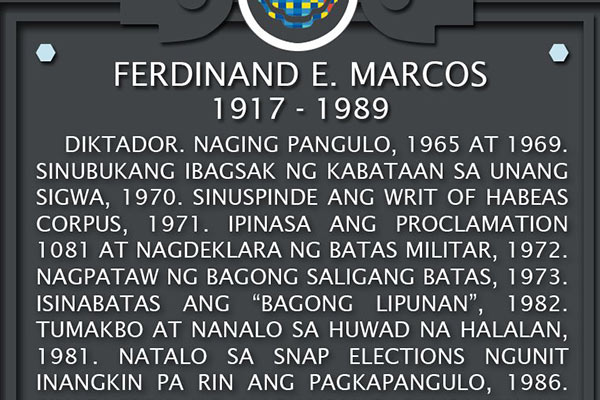MANILA, Philippines — An Ateneo de Manila University organization posted its own version of late dictator Ferdinand Marcos' marker, lamenting the disturbing silence on the one issued to mark the 100th birthday of the strongman.
"Kapansin-pansin na kulang ang nilalaman ng pananda. Marami itong nilaktawang bahagi ng kasaysayan ng bansa sa ilalim ni Marcos na hindi dapat malimutan. Mistulang kasangkapan ng rebisyonismo ang nasabing pananda," Baybayin, an organization focusing on Filipino history and culture, said Monday in a Facebook post.
The National Historical Commission of the Philippines turned over on Sunday the biographical marker of Marcos at a monument in his home province of Ilocos Norte.
The marker read:
Pangulo. Isinilang sa Sarrat, Ilocos Norte, 11 Setyembre 1917, at nanirahan sa Batac. Nagtapos ng abogasya sa Unibersidad ng Pilipinas, 1939. Nanguna sa pagsusulit sa pagkaabogado, 1939. Kasapi ng 14th Infrantry USAFIP-NL ng Kilusang Gerilya, 1944-1945. Nanungkulang kinatawan ng Ikalawang Distrito ng Ilocos Norte, 1949-1959; Senador, 1959-1965. Pangulo ng Senado, 1963-1965. Pangulo ng Pilipinas, 1965-1986. Isinailalim ang Pilipinas sa Batas Militar, 1972-1981. Nagpatupad ng mga programa, proyekto, at batas sa ilalim ng balangkas ng 'Bagong Lipunan.' Bunsod ng EDSA People Power Revolution, 25 Pebrero 1986, namalagi sa Hawaii, Estados Unidos. Yumao, 28 Setyembre 1989.
The absence of the word "dictator" and the use of the word "namalagi" or stayed at to pertain to his exile to Hawaii after he was overthrown from power in 1986 by EDSA revolution prompted questions on whether the NHCP, the primary government agency responsible for history, is institutionalizing historical revisionism.
READ: Historical revisionism legitimized? NHCP issues marker for Marcos monument
The unveiling also happened despite NHCP’s mandate to “resolve historical controversies or issues” and its outright opposition to the Nov. 18, 2016 burial of the strongman’s remains at the Libingan ng mga Bayani.
The controversial hero's burial of Marcos led to the resignation of NHCP head Maria Serena Diokno and two of its board members. Diokno is the daughter of former Sen. Jose “Ka Pepe” Diokno, a staunch critic of Marcos.
Baybayin offered this version of the marker instead:
Diktador. Naging pangulo, 1965 at 1969. Sinubukang ibagsak ng kabataan sa Unang Sigwa, 1970. Sinuspinde ang writ of habeas corpus, 1971. Ipinasa ang proclamation 1081 at nagdeklara ng Batas Militar, 1972. Nagpataw ng Bagong Saligang Batas, 1973. Isinabatas ang 'Bagong Lipunan,' 1982. Tumakbo at nanalo sa guwad na halalan, 1981. Natalo sa snap elections ngunit inangkin pa rin ang pagkapangulo, 1986. Pinabagsak ng nagkaisang sambayanang Filipino, 1986. Tumakas sa Amerika at nanatili roon hanggang yumao, 1989. Patagong inilibing bilang bayani, 2016.
Pinatay, 3,275. Tinortyur, 35,000. Nawala, 1,600. Ninakaw, $10B.
"Upang iwasto ito, gumawa ang Baybayin ng mas kompletong pananda, sa layuning makatutulong itong ipalaganap ang kasaysayan nang buo at tapat, lalo na sa napakamasalimuot at napakahalagang yugtong ito," the group said.
Marcos was accused of committing massive human rights abuses and stealing billions of dollars from state coffers. His body was flown back to the Philippines after the family agreed to certain conditions with then President Fidel Ramos.
READ: 'Wiki warriors' fighting Marcos myths on Wikipedia
President Rodrigo Duterte allowed the burial of Marcos, a campaign vow he made to the Marcoses. Duterte declared the late strongman's birthday a holiday in Ilocos Norte. — Mikas Matsuzawa


